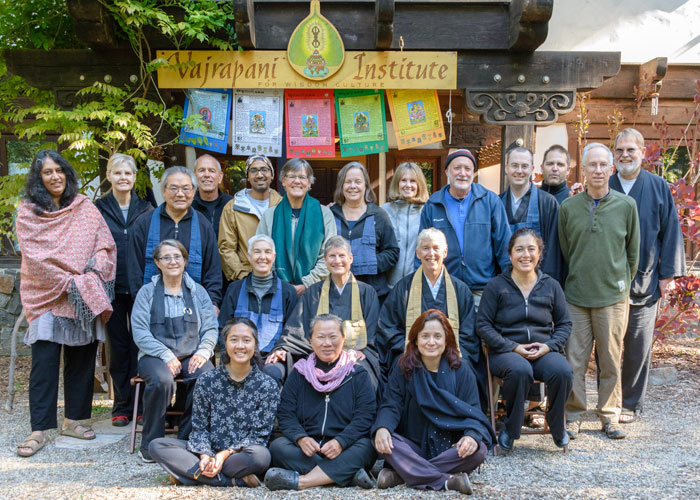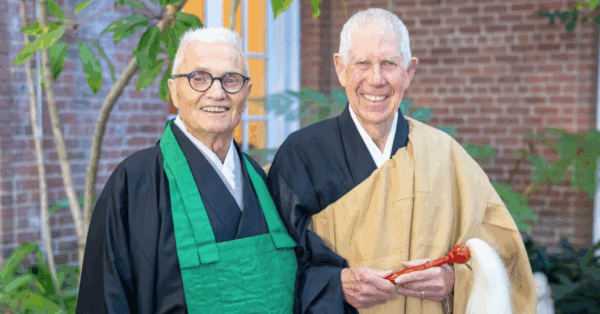A Branching Streams sangha profile
Zen Heart Sangha was established as a weekly sitting group in 1993 by Shungen Misha Merrill, senior dharma heir of Sensei Les Keido Kaye in the Suzuki Roshi lineage. Since that time, the group has grown in both size and maturity, forming a thriving nonresidential community with about 50 active members. We have practice places in both Menlo Park (Monday evenings) and Woodside (Saturday mornings), California, as well as several retreat days a year in various locations.

Zen Heart Sangha at Vajrapani Institute, a local Buddhist retreat center in the redwoods, with Misha Merrill (center) and Jill Kaplan (center right).
From the beginning, the core group of students valued the heart quality of their connection—with their teacher, their sangha and, most importantly, with their practice—so they all agreed that heart needed to be part of the name of our group.
Misha’s teacher, Les Kaye (Kannon Do Meditation Center, Mountain View, CA), started the tradition of being monk-ordained while continuing to work in the lay world, with Suzuki Roshi’s blessing; Misha followed in his footsteps, receiving tokudo (priest ordination) and full dharma transmission in 1998 while continuing to work as an elementary/middle school teacher. This has allowed her to perform both priest and lay ordinations, yet still firmly focus on practice in the context of lay life.

Children sewing miniature cushions for their Buddha statues that they made on another day.
One of the most beneficial outcomes of this emphasis is that we have an unusual number of working couples and families with children practicing together, which seems to encourage greater diversity in our sangha’s population. In addition, it means that lay practitioners are encouraged to take on serious practice positions, as well as ordain as monks with the possibility of becoming teachers themselves. In fact, Misha gave dharma transmission in 2011 to her New York monk Genshin Jane Shuman, who leads a small lay group in Purchase, and then again in 2013 to her senior monk in California, Kakushin Jill Kaplan, who assists with the teaching at Zen Heart Sangha while also working as a therapist in San Jose.
After many years of experimentation with different ways to practice and study, we have evolved a program that is easily accessible to newcomers and older practitioners alike. On the first and third Saturdays of each month, we have a long morning of meditation, full service, oryoki-style breakfast, and soji, followed by a study period. Currently we are studying the Eightfold Path on the first Saturdays and the precepts on the third Saturdays, followed by sewing practice for those preparing for ordinations. Because we understand that lay life (especially with children) is very complicated, we try to teach and hold discussions that everyone can join whether or not they participated in the last related study time. In this way, students are free to join when they can and to take care of their family when that is necessary, without feeling the burden of obligation or anxiety when they can’t participate.
 The second Saturdays of the month are dedicated to Dharma School. This is one of our most joyful offerings—not only do the children love it (and wish we could do it more often!), but the adults that participate enjoy it so much that there is no dearth of volunteers for activities.
The second Saturdays of the month are dedicated to Dharma School. This is one of our most joyful offerings—not only do the children love it (and wish we could do it more often!), but the adults that participate enjoy it so much that there is no dearth of volunteers for activities.
The children practice sitting meditation at the beginning and the end of the two-hour program; they have gradually increased from two or three wiggly minutes to over ten minutes of quiet immovable sitting. We then have a “check-in” to see how everyone is doing, but also to give the children an opportunity to learn how to speak in groups with ease and comfort. This is followed by an activity led by members of our tremendously talented sangha. In the past few years these activities have included tea ceremony, sewing, making mandalas, ikebana, indigo dying, altar construction, cooking, watercolor painting and many other delightful projects. Once the activity is complete, there is a snack time during which Misha reads a story with some dharma message—either a Jataka tale or a book which contains a theme relevant to the dharma. At the end we have another ten-minute sitting and then bow to each other in farewell.

Indigo dying
The fourth Saturday of the month is dedicated to deeper inquiry into some Buddhist sutra or teaching. After trying many different models, we finally settled on one we call Saturday Seminar. To participate in this program, students must make a commitment to attend. While it is understood that emergencies occur, we have found that for this group, at least, making the overall commitment of time is important. This half-day was designed as a training retreat for students who wish to enter the dharma more deeply. Compared to the other Saturdays, there are more periods of zazen, an oryoki breakfast, a longer soji period and a longer study/discussion period. This year we are studying the Genjo Koan, with Misha and Jill taking turns with the presentation.
At this time our group is beginning to feel the pressure of a too-large community in a too-small space—a wonderful problem to have, but difficult to navigate on the San Francisco Peninsula where Silicon Valley rents are mostly beyond our small group’s ability to pay. As we are committed to dana-based funding rather than funding based on membership fees or pledges, we know that we will need to be patient, throwing our net wider into the world while trying to think creatively outside the box. Given the strong commitment we have to providing Zen practice to our local community, we are confident that there is a solution in the near future. Until then, we are happily deepening our practice of Buddha’s Way.
__________
For more about Zen Heart Sangha, visit zenheartsangha.org.
For more information about the Branching Streams network, or to use the directory to find a group near you and read more profiles and news, visit branchingstreams.sfzc.org.











